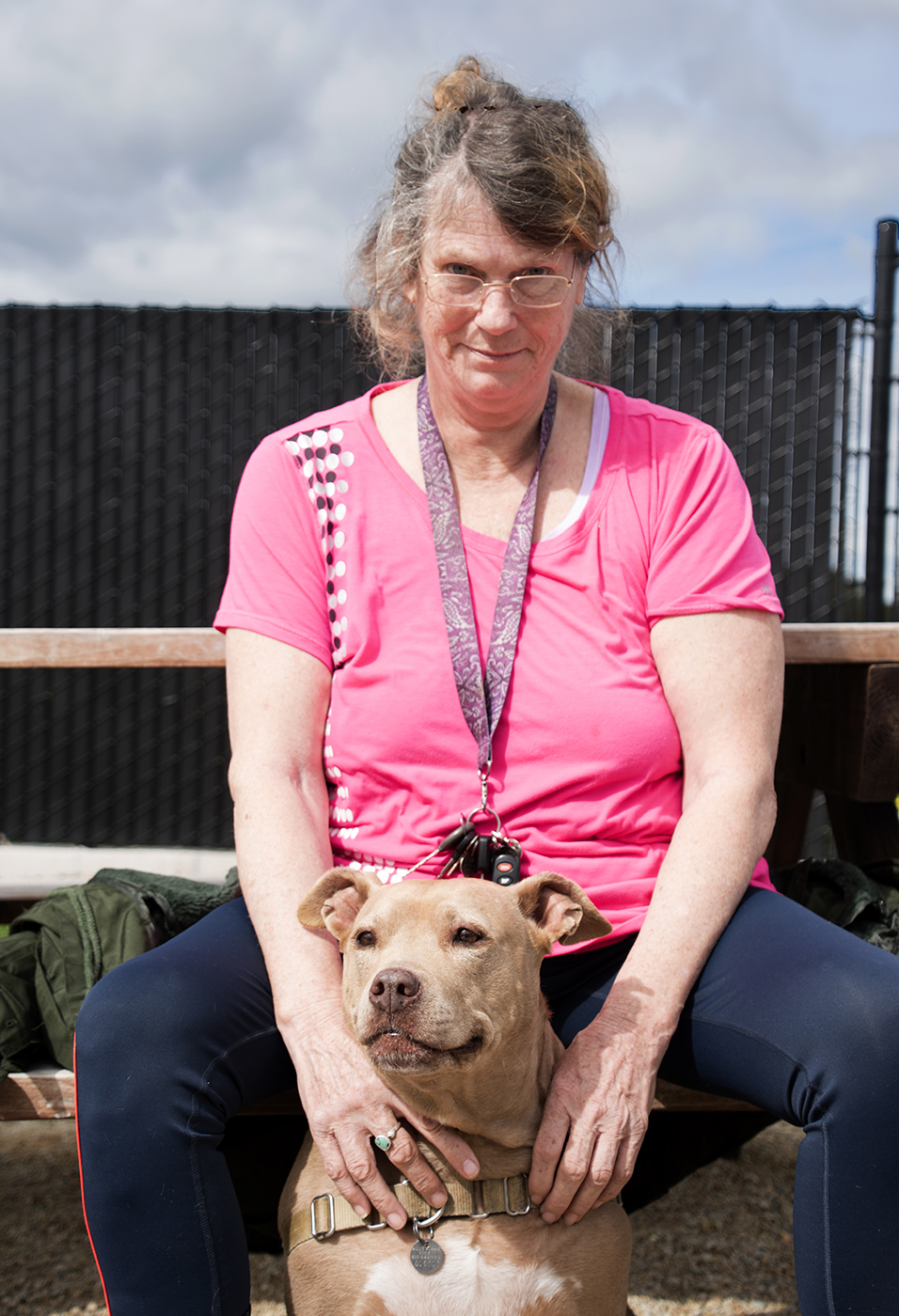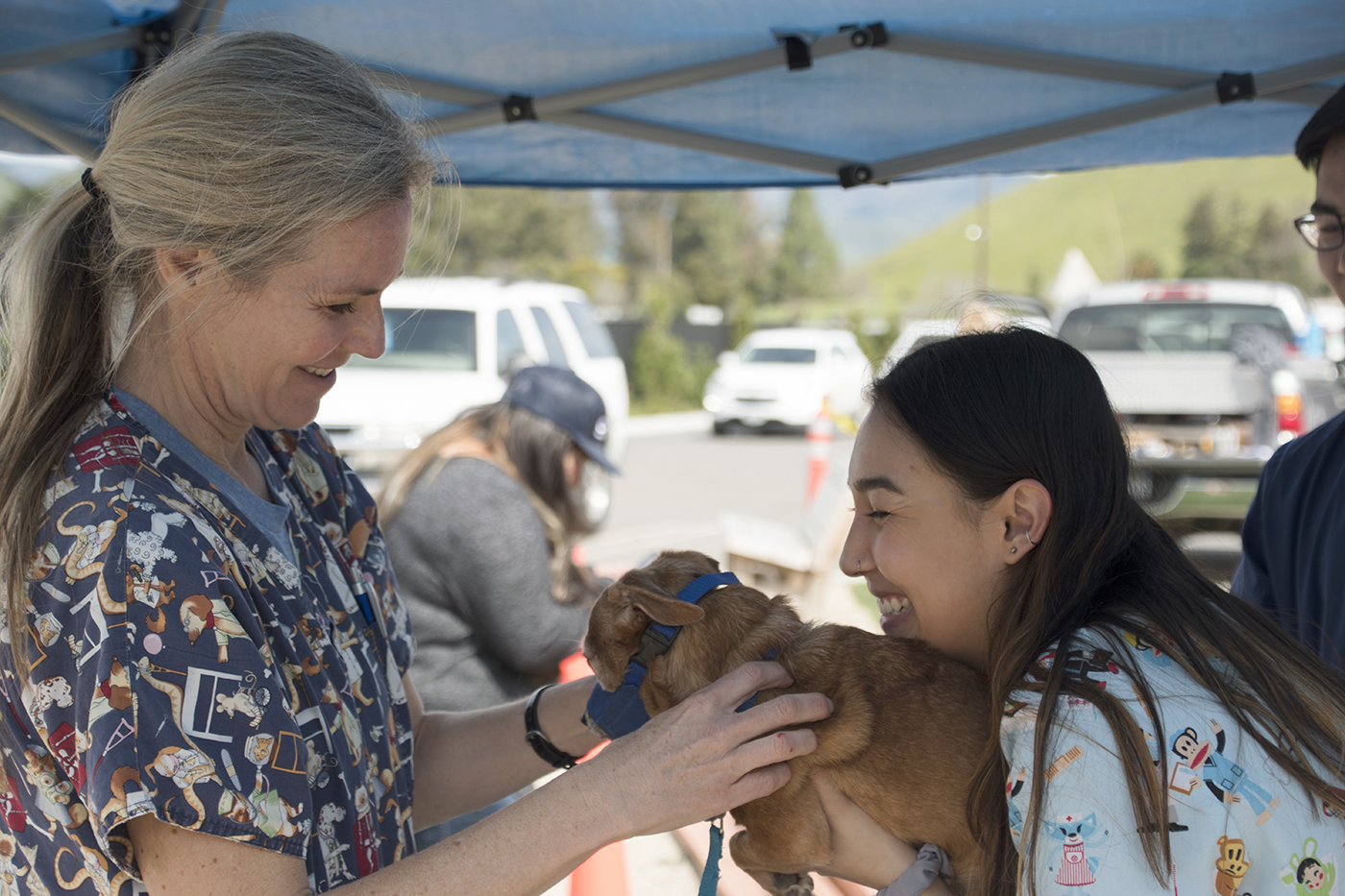On a cloudless, sunny Saturday morning, the Prado Day Center was full of chatter. People were talking, students were working and dogs were barking. Two women set up coolers full of supplies and medicine behind a foldable table and signed people in. On one side, a group set up multiple bins of free items, including dog food. On another, students in a senior project group were building bed risers.
In the center, working on three different tables, students in scrubs were holding dogs for shots and nail clippings and observing their extremities for wellness checks. Their owners sat on wood benches filling out paperwork, while students walked their dogs around the parking lot.
Fifteen Cal Poly students are now solely in charge of a veterinary community service clinic as part of a class newly offered by the Animal Science Department. The clinic administers healthcare checkups and vaccines to animals owned by the homeless population in San Luis Obispo.
“This is just good hands-on experience, and it’s super rewarding working with the homeless individuals,” dairy science junior Danielle Zuk said.

The Veterinary Community Service Clinic (ASCI 490) developed out of the lower-division (ASCI 290) veterinary clinic class. The vet clinic used to put on “Doggy Days” at the homeless services center Prado Day Center twice a quarter, but students and faculty soon realized it was too much to fit into one class.
“Doggy Days” was a senior project idea that initially developed into ASCI 290’s curriculum, but it has since developed into its own enterprise, first offered in Fall 2018. The Animal Science Department’s materials describe enterprise classes as, “[providing] the environment for students to get outside the classroom and work with the animals in teams of students.”
Zuk described the class as “self-sufficient,” with students participating in “extreme Learn by Doing.”
At the beginning of the quarter, students divide themselves up into six groups of about two to three people and each group is put in charge of their own part of the program. The groups can choose from data collection, inventory, communications, budgeting, client communication and fundraising.
“The course is only as successful as you make it,” animal science professor Jennifer Staniec said. “This course is meant to be driven by the students. I’m here as a mediator.”
The class meets once a week on Fridays from 10:10 a.m.-noon. The agenda involves each group telling the class what they have accomplished in the past week. Staniec then mediates any issues going on or throws out ideas for the group to mull over if a roadblock is hit.
Animal science sophomore Shannon Donahue is taking the enterprise for the second time and said she appreciates the part of the class that also benefits the community.
“[We’re] lowering the barriers for the homeless using the shelter services,” Donahue said.
The homeless community members serviced by the class must be clients of the Prado Day Center, Donahue said. The center has kennels inside for animals; however, they must be vaccinated to be allowed in. If the owner’s dog is not vaccinated, they cannot seek shelter there or use any of the center’s services.
In addition to lowering barriers, Staniec said the class is “trying to be in assistance” and that the program is not a handout.
“It helps the homeless in providing stability in keeping their animals with them and in the mental health aspect,” Staniec said.

Theresa Petty, a client of Prado Day Center who lives in their parking lot through San Luis Obispo’s safe parking program, said she is appreciative of the class’ help.
“I could not do this by myself if they weren’t here,” Petty said. “I’ve been coming [to Doggy Days for] over a year. Every month, except when they were on vacation for Thanksgiving and Christmas breaks.”
Petty was able to receive free services, such as flea and tick medicine, nail clippings and a wellness checkup, for her red nose pitbull Niko.
The clients the center sees on “Doggy Days,” like Petty, are generally repeat customers. The amount of patients seen can range from 15 to 29 in a span of three hours, according to Staniec. Students encourage patients to come back so the animals can receive constant check-ups and receive timely shots and/or monthly flea and tick medicine.
One client, Fred Hatfield, returned for his second service to get flea medicine for his dog Dexter. He described his experience with the students as very satisfactory and said that if he did not understand a service they were providing, they made sure to explain it to him thoroughly.
The March 9 “Doggy Days” event was the last held for Winter 2019. However, two more events will be held in Spring 2019. Staniec said she hopes the program will continue on into the summer through a skilled volunteer basis, but she is not certain it will happen as the class is not offered during that term.
Students of any major can go through the application process to be in the class. However, animal science students will get preference, and other non-animal science majors will need to demonstrate their applicable skills to the class, namely animal-related skills.
As for the direction of the program, Staniec said she is hopeful and is looking for students who are a good fit to participate in the class, which will continue “shaping, morphing and developing along with the need and desire for the program.”

